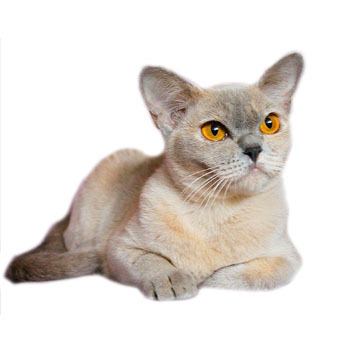
Variety of coat colors
of the European Burmese cat
of the European Burmese cat
According to the International Felinological Federation (FiFe) standards there are only 10 coat colors of the European Burmese cat: brown (bur n), chocolate (bur b), blue (bur a), lilac (bur c), red (bur d), cream (bur e), brown tortie (bur f), chocolate tortie (bur h), blue tortie (bur g) and lilac tortie (bur j).
Brown (sable)
The standard color is a distinctively rich dark brown. Cat face and ears are darker than the body. Nose and paw pads are a rich, dark brown. Any coat patterns are not allowed. Eyes: all shades from yellow to amber are allowed.
Chocolate (Champagne)
The coat is warm milk chocolate, caramel color, turning into golden on the belly. The face and the ears are darker than the body. The nose is a milk chocolate color. Paw pads are chocolate or cinnamon in color. Coat patterns are not allowed. All shades of eyes from yellow to amber are allowed.
Blue
The coat is bluish gray with a light tin shine. Ears, paws and tail are a subtle shade darker. The nose and paw pads are bluish-gray. Any coat patterns are not allowed. All shades of eyes from yellow to amber are allowed.
Lilac (Platinum)
The coat is a light gray with a pinkish tint. The body is a solid color. The cat's face and ears are slightly darker than the body, but without sharp contrasts. The nose and paw pads are lavender pink. Coat patterns are not allowed. All shades of eyes from yellow to amber are allowed.
Red
The coat is a warm orange. The cat's face and ears are darker than the body. The nose and paw pads are chocolate or cinnamon-colored. Stripes on the face, paws and tail are acceptable but undesirable. All shades of eyes from yellow to amber are allowed.
Cream
The coat is pastel cream color. The nose and paw pads are pink. All shades of eyes from yellow to amber are allowed.
Brown tortie
The coat consists of red and black patchings, big and small patchings are acceptable. They should be distinguishable and evenly distributed throughout the body. Color is warm and expressive. Various shades of red are allowed. A reddish or whitish spot on the face is desirable. Patterns on red patches aren't allowed. The nose and paw pads are black, pink or black with pink patches. All shades of eyes from yellow to amber are allowed.
Chocolate tortie
The coat is a milk chocolate color with cream patchings covering the body, paws and tail. The nose and paw pads are milk chocolate, pink or milk chocolate with pink patches. All shades of eyes from yellow to amber are allowed.
Blue tortie
The coat consists of cream and light blue patchings throughout the body and covering the paws and tail. The nose and paw pads are light blue, pink or light blue with pink patches. All shades of eyes from yellow to amber are allowed.
Lilac tortie

The genome of this breed contains several coat color shades. It is typical for the color to be uneven in its intensity. The head, back, tail and paws are noticeably darker, while the sides from the back to the chest will be lighter. The shades of the chest and neck are also lighter than the main color tone. Kittens are born rather light and acquire their color as they get older. In addition to color, the texture of the coat also slightly changes. The final texture of the coat is formed between 1 and 1,5 years.
All coat colors of Burmese cats are unique!
All coat colors of Burmese cats are unique!
A lilac coat with cream patchings covering the body, paws and tail. Patterns are undesirable. The nose and paw pads are lavender pink or lavender pink with light pink patches. All shades of eyes from yellow to amber are allowed.
osinicyna@bk.ru +79101355535